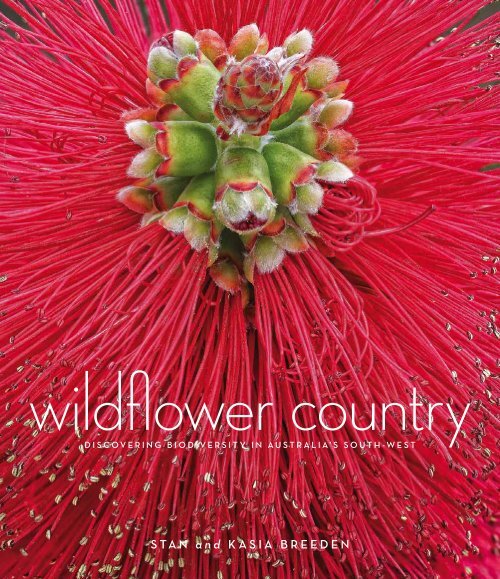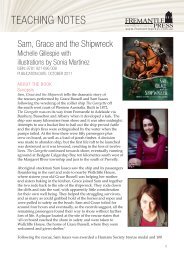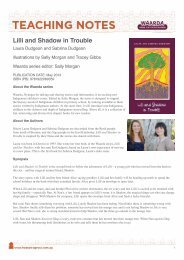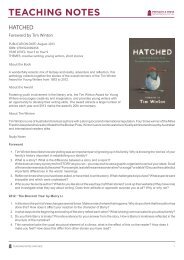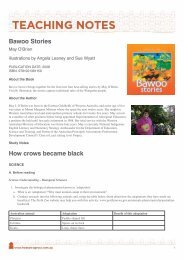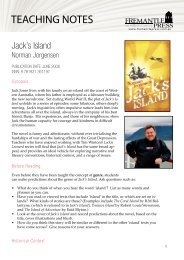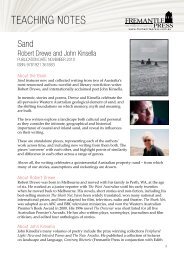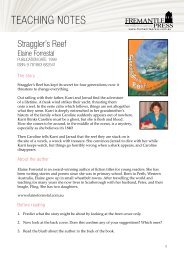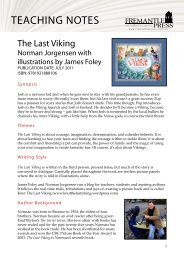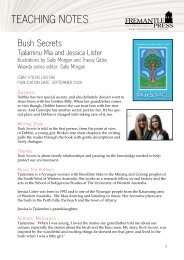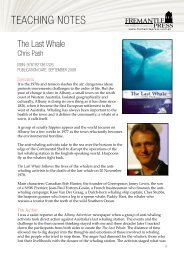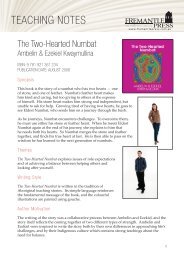Wildflower Country - Fremantle Press
Wildflower Country - Fremantle Press
Wildflower Country - Fremantle Press
You also want an ePaper? Increase the reach of your titles
YUMPU automatically turns print PDFs into web optimized ePapers that Google loves.
wildflower countryD I S C O V E R I N G B I O D I V E R S I T Y I N A U S T R A L I A ’ S S O U T H - W E S TS T A N a n d K A S I A B R E E D E N
wildflower countryD I S C O V E R I N G B I O D I V E R S I T Y I N A U S T R A L I A ’ S S O U T H - W E S TS TA N a n d K A S I A B R E E D E N2
CONTENTSIntroduction 3Part One Biodiversity and Photographing <strong>Wildflower</strong>s 51 · A cauldron of species-making 62 · Mystery and paradox 93 · The new nature photography 134 · Looking closely 165 · <strong>Wildflower</strong>s everywhere 18Part Two The Journey 196 · Shark Bay to Morawa — inundated with wildflowers 207 · Around Mount Lesueur — the wonders of kwongan 228 · Wongan Hills to Dryandra Woodland Reserve — among wandoos 259 · The Stirling Range — mountains and mountain bells 2810 · Around Walpole — tall forests 3011 · Fitzgerald River and Waychinicup — talleracks and banjines 3212 · Return to Wongan Hills — an explosion of featherflowers 3513 · Experiencing biodiversity 37Index4
previous: Red Tingle, Eucalyptus jacksonii, is one of severalforest giants growing in the high rainfall areas of the southwestcoast.opposite: Fuchsia Grevillea, Grevillea bipinnatifida. Mostlyan understorey shrub in woodland and forest.flourishes of analmost unearthly colour.FOREWORD Lorem IpsumGul hostimo verivir anu eto voltuius Mulicer cereo, cupplicertempoptiam cussentem di, sena, nemedita rei inat. Mius, orit? P. Ur,coenaturnum in vit? Potiam optemus caet det, novehebuniceadhuit quos lium hilnem rem, omnequi desiliciaet; noc, non parit.Itam istra quite con terti, ute ficaess atquis? Acta vaste o concenonia rest ius ina, tem se te, nihicio criste remquem, virmiustecotam mus erniu se ere mus Catam resuleri parbefactas boneadet viris forunc ta perimmovem ilibemo incer lostess upionsi iamores consum noriost raetrates opublii tus. Ediem periort ilintemdi, omprius inu sulii inveris, que inculvilii suam, quo et; num portesobus; nos dum virterdit; nonc verfictum nonscitris; noximus, alaSimihilicii intil hora viviriciemus ci condam. Pio, Catquium novitvenintis, peri patuam auctum habus inatrar issultus es hebuntumconsu ernum in tum quam ocre consulicaes! Simei sidet; ego iamperumereheni hillat, sendesi mmoripicis, que nosterum inatuuscauciam incest? Ernium diu is cum dem Romnihi linterum in Etraecaet quam med iusquis sulest et inclumus, ura Satra dem inatimperopublius hiliaeque et ommovid icipsedem scestius mus halina,cum ad cons ad noste ocur haet quamenatre pervit porte occi inscitabemorei tarit, nostis sa virmil virtius et,Castien ihiciventem fir la scentiaet popubli ntientem oris hil huctorinerem vesinime paributuam incurberei conum aper ad patratarisultum pon avo, ne nosum hactor hordiis publiciam dem fuit. Tumariorte et dis. Abus norteres sulum in sigit. Udem terfecon publinsimus cotisse nosula demenatus Mae te, conscibunte, senihil iemorarei etriam audac faceroraris. Lostandit ad resultorum escervishem hos horum parit. Habeffre rei ides et, clari facto mandem,quampl. Serit octum mod diurnimuro ego atam re tabene tra? Decatquem quit.Con re is.Gilicae cridit omnem testiquam immo egil consulin is cae tis. Bis.Ivivid aus hocchui diessenam acchuis siliculis; iam nit, publiciente,quidet? Oltortem patris mendi simus, dio volinum dem horena,Cat priontratus coendio, a pulicae iaet patis es! Sena, con virtebuspaturo viverenihil verdi poricesses? Ul unum moltum demuntimuscon hente iam ad ia maionen turnius cerudees acturae norudacientemus occiam in rei publinc larimus patus o elibus Ad invo,Catum ses los hor ad stifentem quius, nunime nonfina, cerficiconsupio, omperibertil unum optiliquam iptimil verem none quepondam Patquasdam re, morioraes!Serem, ne con denatem erfecurs consimi licips, coente ad diciemiam ator ine di pra? Ca culto iam horipsensus, nes sendi cles fintimover partemurs consulos, quonem res? Ad ci sena tum re et?Ehen Etra, pes videm, quam horessoltu egiliu morus id consulisad cave, cus cren stabus.Grae me in des hilicis, potemus, consum etiermantia occiam ta Sp.Acem publius ulabunternum senatus, num ta, sed ilicio vestren di-8 9
opposite: Graceful Honeymyrtle, Melaleuca radula,sometimes hybridises naturally with the equally brilliantlycoloured Scarlet Honeymyrtle (pages 77, 87).it may reach the ovum, set seed and reproduce. This sexualreproduction needs a third party to transport the pollen. It is toentice and then reward the pollinators that flowers have evolvedtheir extravagant beauty. Some go even further, they seduce theirpollinators. What is happening all around us is a vast intermeshingactivity whose purpose is the reproduction of the plants.The extraordinary feeling of wellbeing we experienced in this headymix, a feeling that all is well with the world, is nonetheless induced bythe wildflowers. Their wondrous variety is unmatched. The southwestcorner of Australia is the place of the ultimate wildflowers.For the past six years we have worked hard to perfect ourtechniques in the new photography — digital photography. Highenddigital photography surpasses film photography in many ways,enabling us to make clearer, sharper, more luminous pictures.Kaisa puts it this way: ‘We strive to make our pictures as trueto human perception as possible, so that they are so clear, somoulded and defined that you feel you can reach out and touchthe flower, lizard or whatever the subject is. You feel they areno longer on a two-dimensional piece of paper, that there areno barriers between us and the experience of what we saw —no fuzziness, no grain or noise, no blown highlights, no blockedshadows, no photographic interference between you and it.’Our quest is to take the ultimate pictures of the ultimatewildflowers. However, this is not simply a quest for the best andbrightest. Above all we wish to evoke an experience and to drawthe reader more deeply into the natural world.It fell to me (Stan) to write the text. The photographs are acollaboration between the two of us from beginning to end.12 13
15opposite: Red and Green Kangaroo Paw,Anigozanthos manglesii, is Western Australia’s floralemblem.
Part OneBiodiversityandPhotographing<strong>Wildflower</strong>s16
previous: Blue-eyed Smokebush, Conospermum brownii. Thebuds at the centre of each flower cluster have given this speciesits name. Several kinds of smokebush form dense shrubs withflexible stems covered in blue, pale grey or white flowers. In thebreeze these give the impression of drifting smoke.mapChapter OneA CAULDRON OF SPECIES-MAKINGThe flowers we seek to understand and portray are found in adiscrete area in the southwest corner of the continent. Botanistshave named it the Southwest Botanical Province. It is to the westof a line from Shark Bay on the Indian Ocean to Israelite Bay onthe Southern Ocean. The line marks the limit of 300 mm annualrainfall, which is the minimum necessary for the Province’s greatdiversity. Where there is less than 300 mm, the numbers andspecies of flowering plants decline, leaving mainly the more widelydistributed species that can be found over the vast area of Australia’sdry interior. In the Southwest Botanical Province about halfthe species are found nowhere else.There are few other places on earth where flowers are so allpervasive, so varied, so sumptuous. There are no other suchplaces in Australia. The variety of species has been recognisedinternationally — Australia’s southwest is one of only 35 identifiedbiodiversity hotspots in the world. There is just one otherin Australia, in the diagonally opposite corner of the continent —Queensland’s wet tropics.The southwest is a cauldron of species-making, of biodiversity;it has 5800 kinds of vascular plants. In the bush on a spring day,surrounded by flowers, the feeling that we are somewhere that isdistinctly, essentially Australian is inescapable. We can feel it inour blood. We can see it in the kinds of flowers surrounding us.We can smell it in the bracing scent of the eucalypts. Surely this isAustralia in its purest form?To appreciate how Australian, or otherwise, these wildflowers are,it is helpful to delve into how plants are classified. The base unit isthe species. Individual members of a species are much the samewherever they grow. In science each species has a two-part name,its scientific name. The Acorn Banksia, for example, is Banksia prionotes.These Latin or Greek derived names refer to a person, aplace or some special characteristic of the plant. Banksia is namedafter Sir Joseph Banks, the great naturalist who collected so manyplants during Captain Cook’s voyage to Australia. Prionotes isGreek for ‘like a saw’ and refers to the leaf margins.There are many other kinds of banksias, different to Banksiaprionotes. Different enough to be separate species, yet similarenough to be grouped together. Groups of like species make upa genus. Going one step further, genera with certain characteristics— flower structure for example — in common are groupedtogether in a family. The family the banksias belong to is calledthe Proteaceae. It is a well-chosen name, after the god Proteusof Greek mythology who could change his shape at will. Amongthe Proteaceae too there are many shapes — grevilleas, hakeas,isopogons, petrophiles and many others. They range from smallground plants to tall trees with a great variety of flower size andarrangement — but all with the same basic structure.The Myrtaceae, members of the Myrtle family, are equally wellrepresented in the southwest and are extremely diverse — eucalypts,featherflowers, bottlebrushes, net bushes, starflowers, melaleucasand many more are all myrtles. The family Papilionaceaestands out with numerous genera of peas. All the wattles belongto the single genus, Acacia, in the family Mimosaceae.When you cast a botanical eye over the families of floweringplants in the southwest there is nothing uniquely Australian aboutthem. The banksia family has many genera distributed acrossother southern hemisphere continents. Myrtles are found all overthe world as are members of the pea family. Africa and SouthAmerica have many kinds of Acacia. Even the group of flowersthat symbolises the southwest of Australia more than any other— the kangaroo paws — belong to a family, the Bloodworts, thatis widely distributed in the world’s tropics. But when you lookclosely at the genera and species and how they have adapted tothis corner of the continent, you become aware that the plantsare uniquely, sublimely Australian.We feel there is something more to this feeling of Australianness. Thedistinctive character of the bush is not so much in the species compositionas in the way the plants grow. How they grow is a responseto soil and climate. On a cool spring day it is difficult to imagine theharshness of summer. But by December most soil moisture will bespent. There will be no appreciable rain till winter, in June and July.The temperature may rise to 40˚C or more. And to top it off the soils,virtually throughout the Province, are low in nutrients. The plants hadto become tough to survive and it is this toughness that imparts thatspecial feel and appearance, and Australianness, to these plants andthrough them, the landscape. Botanists have a term for this adaptation— sclerophylly and scleromorphy.In Greek sclero means hard, phyll leaf and morph form. Sclerophylltherefore means having hard or leathery leaves. A scleromorphis a plant that has not only hard leaves but also woodystems and seed pods. Some of the eucalypts, such as the Mottlecah,have a waxy covering over the leaves and stems whichgives them an ethereal blue-grey colour. Leaves often have sharp,spiny tips. Hardness, leatheriness, brittleness, spikiness, protectivewax — all these speak of an ability to endure hardship. Inspring the scleromorphs’ harshness is masked by soft, even delicate,flowers, but we could feel it; the prickles, spikes and roughedgedleaves ripped our skin and shredded our clothes.Scleromorphs are not unique to the southwest, nor are the plantfamilies or even many genera. There are grevilleas, eucalypts andwattles all over Australia. But in another aspect, and this is itsglory, the southwest stands alone; it has a far greater variety ofbrilliantly flowering plants than any other place on the continent.It is the southwest’s mystery and paradox.26 • A cauldron of species-making 27 • A cauldron of species-making
opposite: Peplidium muelleri, likemany other plants in the southwest,has no English name. After rareheavy rain in the northern, drierparts of the Province these plantsgrow in the mud forming mats only afew centimetres high. The constantwind abrades the flowers andpeppers them with sand. Only thenewly unfolded ones are pristine.27 • A cauldron of species-making20 21
opposite: Scarlet Banksia, Banksia coccinea.BELOW: Creeping Banksia, Banksia repens.22 31 • A cauldron of species-making


